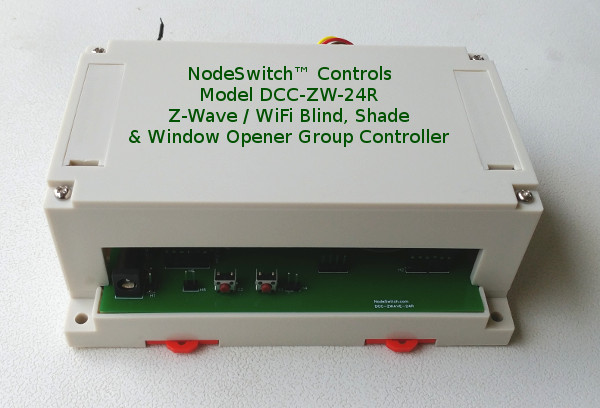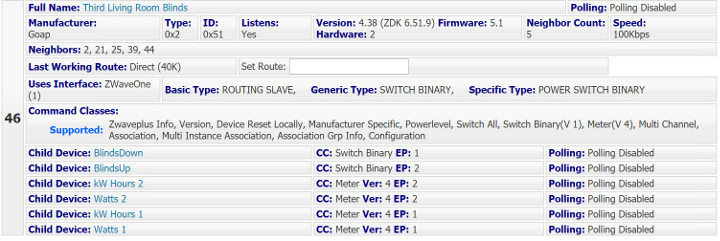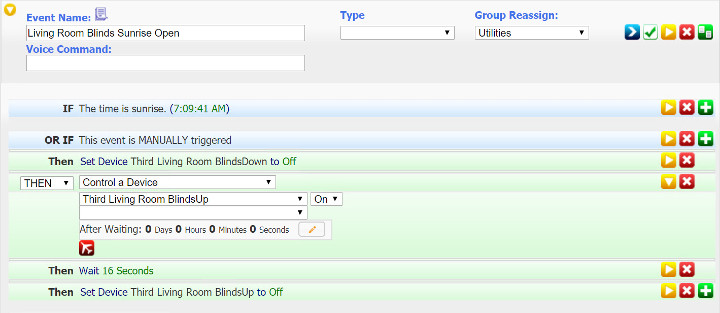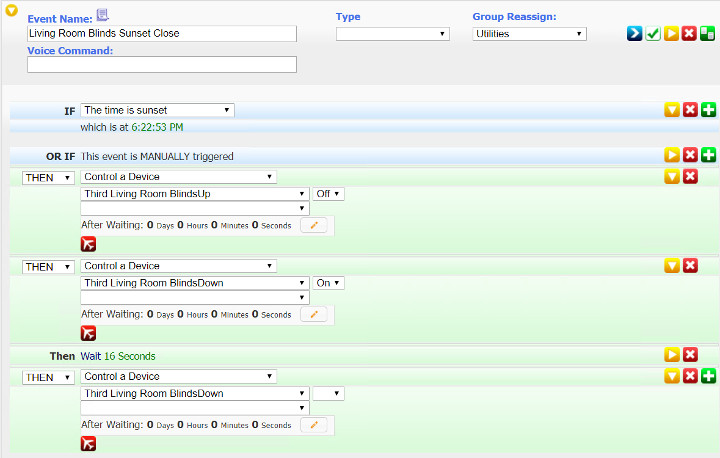Z-Wave & WiFi Group Control: Using the Homeseer™ System
 We are very grateful to Ron C. for providing this guide to using our Z-Wave motor controller with the Homeseer™ system.
We are very grateful to Ron C. for providing this guide to using our Z-Wave motor controller with the Homeseer™ system.
As Ron points out, his Z-Wave motor control configuration instructions will likely save time for others that enjoy using the Homeseer™ system.
As mentioned in Part 1A of this article series, we learned how to clone your radio motors to the group transmitter.
If you haven't yet assigned your radio motors to the transmitter, please see Part 1A: Cloning Motor Channels that explains how to do this. It is important that you do this first, before proceeding with this Z-Wave setup.
Configuring the Zwave Controller to Work With the Homeseer™ System
Here are Ron's Instructions:
[Editor's note: the first part is a reminder to program your transmitter (and remotes) as per the above paragraphs]
This regards how to set up the home automation Z-Wave controlling device supplied by Rollertrol for use with HomeSeer. This blind control kit (DCK-ZW-24RNA) is a single channel GROUP controller kit for our motorized blinds and shades, window openers, skylight shades, motorized drapery and curtain kits, and other reversible motors.
The kit consists of the DCC-ZW-24R controller unit, a 24v DC power supply, and a group transmitter for our radio motors. This device can control multiple blind motors, but they will be controlled as a group all at one time. It does not provide control of these motors individually. This is what is meant by "single channel".
The order of procedure is to first enroll the blind(s) you wish to control to the hand-held remote control and to set the limits using the instructions provided for the remote. You will always be able to use the remote in addition to enjoying the automation provided by HomeSeer and the DCC kit.
Once the blinds operate to both upper and lower limits as you desire, then follow the instructions for linking the remote’s settings into the Z-Wave Blind Control Kit DCC-ZW-24R.
HomeSeer Setup for the DCC controller
You can use the app called Z-Tools+ to add the DCC to HomeSeer, or you can use HomeSeer itself to poll for the new device. Once HomeSeer is searching for the device, simply press the DCC’s #1 button once or twice while in the same room as your HomeTroller/Z-Wave interface. HomeSeer will detect the DCC activity and add it to HomeSeer as a NODE.

During the addition if using Z-Tools+, or afterwards in the "Plug-Ins"/Z-Wave/Node Information menu you can rename the "Full Name" from Node XX (46 in this picture) to "Third Living Room Blinds" or whatever is suitable for your installation.
You will find it useful to rename the default Child Device Names for switch one and switch two as I have, "BlindsDown" and "BlindsUp". In HomeSeer, turning ON the switch causes the blinds to go active – either up or down depending on which switch – but make note that the blinds will not move if BOTH switches are set to "ON".
When you define automatic events in HomeSeer you must insure to issue a command to turn OFF the opposing action first, then turn on the desired action, have the HomeSeer WAIT for sufficient time for the blinds to complete the motion desired, and then turn OFF the action (Child Device).
Here are screenshots of several events which will close the blind automatically at sunset each day, and then open them each sunrise. Of course, instead of the event of sunrise or sunset, you can elect this action to happen at a specific time, such as 3pm on Sundays, or when the sensor on your garage door opens, or when the temperature inside rises to a specific point, or only on specific days of the week, or when an occupancy sensor detects you have left the room, etc..
In HomeSeer there are many ways to design events to accomplish a desired goal. These samples are very basic and simple, but do perform flawlessly the task at hand.
First, the sunrise OPEN event, which has two triggers – either the sunrise for the day which HomeSeer adjusts automatically every day based on your longitude & latitude, or a manual trigger if you wish to "test" the event at any time. Once either trigger is "true" then the event will make sure the opposing switch "BlindsDown" in the DCC is turned off so it will not block the BlindsUp switch, and then turn on the BlindsUp switch.
While BlindsUp is on HomeSeer will then WAIT 16 seconds. The blinds in this case only take about 10 seconds to go up but it is better to have some buffer time to insure the blinds perform uniformly to reach the upper limit you have set, and then the event will turn OFF the BlindsUp switch. During the 16 seconds the blinds will travel to the limit you set using the hand-held remote and stop.
While you might think it would work to not set limits and instead use precise timing to drive the blinds, in reality there can be some variation in the speed of the motors which might cause poor alignment that would not look as good, particularly if you are using room-darkening shades. Nothing provides better precision for your RollerTrol blinds than setting the limits.

Once you have defined the above event, you can simply click on the "copy" icon (the green icon to the right of the Group Reassign value of "Utilities" in the above picture, which has two sheets of paper in the body of the icon. It will copy the entire event, and you can rename it as well as change the device names so that the event CLOSES the blinds upon "The Time is sunset".
Here is the event which closes the blinds daily at sunset:

For those of you interested in controlling blinds and window/skylight motors, Alexa has a Homeseer skill such that the blinds can be controlled by voice.
[Editor's Note: This is the end of Ron's instructions]
A Word About Digital Radio Signal Range
The antenna position affects range profoundly. If you wall mount the controller with the Zwave antenna pointing straight up, you will usually get the best results. We have tested a single installation here with about 60 feet of range with the Zwave hub on one floor and the controller on a second floor, with about 4 rooms in between (typical wood frame/sheetrock home construction).
It is important to understand that the radio signal that is transmitted from the controller to the motor is much more powerful than the Zwave signal - it will reach anywhere in a typical home, so it's ok to put the controller close to the Zwave hub and let the direct motor control signal do the heavy lifting.
Also, keep in mind that most Zwave devices are also 'signal forwarders' (including the Qubino unit in our controller) so adding more devices in your home should improve the Zwave range results.
If you are dealing with a concrete or cinder block structure, please note that your radio signals will not have as much range.
Purchase This Unit in Our Online Store
You can purchase our Unity group controller for blinds and window openers, and our other control products in our online DIY automation store.
Adrian Biffen
Senior Partner
NodeSwitch™ Controls
We sincerely hope you enjoy our advanced technology products; if you have any questions, please contact us at any time!
Articles in this series:
Part 1: Z-Wave Group Control of Blind & Shade Motors: Introduction
Part 1A: Z-Wave & WiFi Blind Control: Cloning Motor Channels
Part 2: Blind Motor Quick Start Pairing With Your Z-Wave Hub
Part 2A: Homeseer Blind Motor Control with Zwave (you are here)

 Shopping Cart Home - Start Here
Shopping Cart Home - Start Here Z-Wave Motor Control
Z-Wave Motor Control Remote Controls for Radio Equipped Motors
Remote Controls for Radio Equipped Motors DIY Starter Kits for Window Shades
DIY Starter Kits for Window Shades DIY Starter Kits for Window Openers
DIY Starter Kits for Window Openers Alexa & Broadlink RM4 Pro Home Theater Control
Alexa & Broadlink RM4 Pro Home Theater Control Zwave Motor Control: Introduction
Zwave Motor Control: Introduction Shelly WiFi Wireless Motor Control
Shelly WiFi Wireless Motor Control Zigbee Motor Control (Under Development)
Zigbee Motor Control (Under Development) Raspberry Pi as a Home Automation Hub
Raspberry Pi as a Home Automation Hub Hubitat Elevation & Broadlink RM Pro Emitter
Hubitat Elevation & Broadlink RM Pro Emitter Blind Motors
Blind Motors Window Openers
Window Openers Skylight Openers
Skylight Openers Shade Slider
Shade Slider Curtain Closer
Curtain Closer Track Glider
Track Glider Background & Mission Statement
Background & Mission Statement Customer DIY Testimonials
Customer DIY Testimonials Contact Page
Contact Page